Pecan
The pecan /pɪˈkæn/ (Carya illinoinensis) is a species of hickory native to northern Mexico and the southern United States in the region of the Mississippi River.[1] The tree is cultivated for its seed in the southern United States, primarily in Georgia[2] and Texas,[3] and in Mexico which produces nearly half of the world total. The seed is an edible nut used as a snack and in various recipes, such as praline candy and pecan pie. The pecan, in various aspects, is included in state symbols of Alabama, Arkansas, California, Oklahoma and Texas.
| Pecan | |
|---|---|
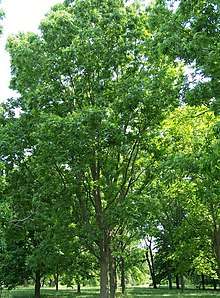 | |
| Carya illinoinensis Morton Arboretum acc. 1082-39*3 | |
| Scientific classification | |
| Kingdom: | Plantae |
| Clade: | Tracheophytes |
| Clade: | Angiosperms |
| Clade: | Eudicots |
| Clade: | Rosids |
| Order: | Fagales |
| Family: | Juglandaceae |
| Genus: | Carya |
| Section: | Carya sect. Apocarya |
| Species: | C. illinoinensis |
| Binomial name | |
| Carya illinoinensis | |
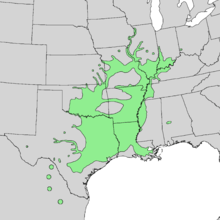 | |
| Natural range of Carya illinoinensis | |
| Synonyms[1] | |
| |
Name
"Pecan" is from an Algonquian word variously referring to pecans, walnuts and hickory nuts.[4] There are many variant pronunciations, some regional and others not.[5] The most common American pronunciation is /pɪˈkɑːn/; the most common British one is /pɪˈkæn/.[5] There is little agreement in the United States, even regionally, as to the "correct" pronunciation.[6]
Growth
The pecan tree is a large deciduous tree, growing to 20–40 m (66–131 ft) in height, rarely to 44 m (144 ft).[7] It typically has a spread of 12–23 m (39–75 ft) with a trunk up to 2 m (6 ft 7 in) diameter. A 10-year-old sapling grown in optimal conditions will stand about 5 m (16 ft) tall. The leaves are alternate, 30–45 cm (12–18 in) long, and pinnate with 9–17 leaflets, each leaflet 5–12 cm (2–4 1⁄2 in) long and 2–6 cm (1–2 1⁄2 in) broad.[7]
A pecan, like the fruit of all other members of the hickory genus, is not truly a nut, but is technically a drupe, a fruit with a single stone or pit, surrounded by a husk. The husks are produced from the exocarp tissue of the flower, while the part known as the nut develops from the endocarp and contains the seed. The husk itself is aeneous, that is, brassy greenish-gold in color, oval to oblong in shape, 2.6–6 cm (1–2 3⁄8 in) long and 1.5–3 cm (5⁄8–1 1⁄8 in) broad. The outer husk is 3–4 mm (1⁄8–5⁄32 in) thick, starts out green and turns brown at maturity, at which time it splits off in four sections to release the thin-shelled seed.[7][8][9][10]
Cultivation
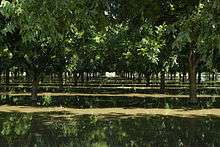
Pecans were one of the most recently domesticated major crops. Although wild pecans were well known among native and colonial Americans as a delicacy, the commercial growing of pecans in the United States did not begin until the 1880s.[11] As of 2014, the United States produced an annual crop of 119.8 million kilograms (264.2 million pounds), with 75% of the total crop produced in Georgia, New Mexico and Texas.[12] They can be grown from USDA hardiness zones approximately 5 to 9, and grow best where summers are long, hot and humid. The nut harvest for growers is typically around mid-October. Outside the United States, Mexico produces nearly half of the world total, similar in volume to the United States, together accounting for 93% of global production.[13] Generally, two or more trees of different cultivars must be present to pollinate each other.[14]
Choosing cultivars can be a complex practice, based on the Alternate Bearing Index (ABI) and their period of pollinating.[14] Commercial growers are most concerned with the ABI, which describes a cultivar's likelihood to bear on alternating years (index of 1.0 signifies highest likelihood of bearing little to nothing every other year). The period of pollination groups all cultivars into two families: those that shed pollen before they can receive pollen (protandrous), and those that shed pollen after becoming receptive to pollen (protogynous).[15] State level resources provide recommended varieties for specific regions.[16][17]
Native pecans in Mexico are adapted from zone 9 to zone 11.[18] Little or no breeding work has been done with these populations. A few selections from native stands have been made such as Frutosa and Norteña which are recommended for cultivation in Mexico.[19][20] Improved varieties recommended for cultivation in Mexico are USDA developed cultivars. This represents a gap in breeding development given that native pecans can be cultivated at least down to the Yucatan peninsula while the USDA cultivars have chilling hour requirements greater than occur in much of the region.[21] Some regions of the U.S. such as parts of Florida and Puerto Rico are zone 10 or higher, and these regions have limited options for pecan cultivation. 'Western' is the only commonly available variety that can make a crop in low chill zones.[22]
Breeding and selection programs
Active breeding and selection is carried out by the USDA Agricultural Research Service with growing locations at Brownwood and College Station, Texas.[23] University of Georgia has a breeding program at the Tifton campus working to select pecan varieties adapted to subtropical southeastern U.S. growing conditions.[2]
While selection work has been done since the late 19th century, most acreage of pecans grown today is of older cultivars, such as 'Stuart', 'Schley', 'Elliott', and 'Desirable', with known flaws but also with known production potential. Cultivars, such as 'Elliot', are increasing in popularity due to resistance to Pecan scab.[24] The long cycle time for pecan trees plus financial considerations dictate that new varieties go through an extensive vetting process before being widely planted. Numerous varieties produce well in Texas, but fail in the Southeastern U.S. due to increased disease pressure. Selection programs are ongoing at the state level, with Alabama, Arkansas, Florida, Georgia, Kansas, Missouri, New Mexico, and others having trial plantings.
Varieties adapted from the southern tier of states north through some parts of Iowa and even into southern Canada are available from nurseries. Production potential drops significantly when planted further north than Tennessee. Most breeding efforts for northern-adapted varieties have not been on a large enough scale to significantly affect production. Varieties that are available and adapted (e.g., 'Major', 'Martzahn', 'Witte', 'Greenriver', 'Mullahy', and 'Posey') in zones 6 and farther north are almost entirely selections from wild stands. Kanza, a northern-adapted release from the USDA breeding program, is a grafted pecan having high productivity and quality, and cold tolerance.[25]
Diseases, pests, and disorders
Pecans are subject to a wide range of diseases, pests, and physiological disorders that can limit tree growth and fruit production. These range from scab to hickory shuckworm to shuck decline.
Pecans are prone to infection by bacteria and fungi such as Pecan scab, especially in humid conditions. Scab is currently the most destructive disease affecting pecan trees untreated with fungicides. Recommendations for preventive spray materials and schedules are available from state level resources.
Various insects feed on the leaves stems and developing nuts. These include ambrosia beetles, twig girdlers, pecan nut casebearer, hickory shuckworm, phylloxera, curculio, weevils, and several aphid species.
In the Southeastern United States, nickel deficiency in C. illinoinensis produces a disorder called mouse-ear in trees fertilized with urea.[26] Similarly, zinc deficiency causes rosetting of the leaves. Various other disorders are documented, including canker disease and shuck decline complex.
Food and wood
The seeds of the pecan are edible, with a rich, buttery flavor. They can be eaten fresh or used in cooking, particularly in sweet desserts, such as pecan pie, a traditional Southern U.S. dish. Pecans are a major ingredient in American praline candy.[27] Other applications of cooking with pecans include pecan oil and pecan butter.
Pecan wood is used in making furniture and wood flooring,[28] as well as a flavoring fuel for smoking meats, giving grilled foods a sweet and nutty flavor stronger than many fruit woods.[29]
Nutrition
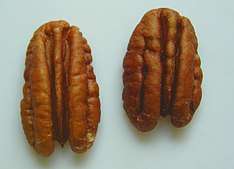 | |
| Nutritional value per 100 grams | |
|---|---|
| Energy | 2,889 kJ (690 kcal) |
13.86 | |
| Starch | 0.46 |
| Sugars | 3.97 |
| Dietary fiber | 9.6 |
71.97 | |
| Saturated | 6.18 |
| Monounsaturated | 40.801 |
| Polyunsaturated | 21.614 |
9.17 | |
| Vitamins | Quantity %DV† |
| Vitamin A equiv. | 0% 29 μg17 μg |
| Vitamin A | 56 IU |
| Thiamine (B1) | 57% 0.66 mg |
| Riboflavin (B2) | 11% 0.13 mg |
| Niacin (B3) | 8% 1.167 mg |
| Pantothenic acid (B5) | 17% 0.863 mg |
| Vitamin B6 | 16% 0.21 mg |
| Folate (B9) | 6% 22 μg |
| Vitamin C | 1% 1.1 mg |
| Vitamin D | 0% 0 μg |
| Vitamin E | 9% 1.4 mg |
| Vitamin K | 3% 3.5 μg |
| Minerals | Quantity %DV† |
| Calcium | 7% 70 mg |
| Iron | 19% 2.53 mg |
| Magnesium | 34% 121 mg |
| Manganese | 214% 4.5 mg |
| Phosphorus | 40% 277 mg |
| Potassium | 9% 410 mg |
| Sodium | 0% 0 mg |
| Zinc | 48% 4.53 mg |
| Other constituents | Quantity |
| Water | 3.52 |
| |
| †Percentages are roughly approximated using US recommendations for adults. Source: USDA Nutrient Database | |
A pecan nut is 4% water, 72% fat, 9% protein, and 14% carbohydrates (table). In a 100 g reference amount, pecans provide 691 Calories and a rich source (20% or more of the Daily Value, DV) of total fat, protein, dietary fiber (38% DV), manganese (214% DV), magnesium (34% DV), phosphorus (40% DV), zinc (48% DV), and thiamin (57% DV) (table).[30] Pecans are a moderate source (10-19% DV) of iron and B vitamins. Pecan fat content consists principally of monounsaturated fatty acids, mainly oleic acid (57% of total fat), and the polyunsaturated fatty acid, linoleic acid (30% of total fat).[30]
Evolutionary development
The pecan, Carya illinoinensis, is a member of the Juglandaceae family. Juglandaceae are represented worldwide by between seven and 10 extant genera and more than 60 species. Most of these species are concentrated in the Northern Hemisphere of the New World, but some can be found on every continent except for Antarctica. The first fossil examples of the family appear during the Cretaceous. Differentiation between the subfamilies of Engelhardioideae and Juglandioideae occurred during the early Paleogene, about 64 million years ago. Extant examples of Engelhardioideae are generally tropical and evergreen, while those of Juglandioideae are deciduous and found in more temperate zones. The second major step in the development of pecan was a change from wind-dispersed fruits to animal dispersion. This dispersal strategy coincides with the development of a husk around the fruit and a drastic change in the relative concentrations of fatty acids. The ratio of oleic to linoleic acids are inverted between wind- and animal-dispersed seeds.[31][32] Further differentiation from other species of Juglandaceae occurred about 44 million years ago during the Eocene. The fruits of the pecan genus Carya differ from those of the walnut genus Juglans only in the formation of the husk of the fruit. The husks of walnuts develop from the bracts, bracteoles, and sepals, or sepals only. The husks of pecans develop from the bracts and the bracteoles only.[32]
History
Before European settlement, pecans were widely consumed and traded by Native Americans. As a wild forage, the fruit of the previous growing season is commonly still edible when found on the ground.
Pecans first became known to Europeans in the 16th century. The first Europeans to come into contact with pecans were Spanish explorers in what is now Louisiana, Texas, and Mexico. These Spanish explorers called the pecan, nuez de la arruga, which roughly translates to "wrinkle nut". Because of their familiarity with the genus Juglans, these early explorers referred to the nuts as nogales and nueces, the Spanish terms for "walnut trees" and "fruit of the walnut". They noted the particularly thin shell and acorn-like shape of the fruit, indicating they were indeed referring to pecans. The Spaniards took the pecan into Europe, Asia, and Africa beginning in the 16th century. In 1792, William Bartram reported in his botanical book, Travels, a nut tree, Juglans exalata that some botanists today argue was the American pecan tree, but others argue was hickory, Carya ovata. Pecan trees are native to the United States, and writing about the pecan tree goes back to the nation's founders. Thomas Jefferson planted pecan trees, C. illinoinensis (Illinois nuts), in his nut orchard at his home, Monticello, in Virginia. George Washington reported in his journal that Thomas Jefferson gave him "Illinois nuts", pecans, which Washington then grew at Mount Vernon, his Virginia home.
Commercial production of pecans was slow because trees are slow to mature and bear fruit. More importantly, the trees grown from nuts of one tree have very diverse characters. To speed nut production and retain the best tree characteristics, grafting from mature productive trees was the obvious strategy. However, this proved technically difficult. The Centennial cultivar was the first to be successfully grafted. This was accomplished by a slave called Antoine in 1846 or 1847, who was owned by Jacques Telesphore Roman of the Oak Alley Plantation near the Mississippi river. The scions were supplied by Dr. A. E. Colomb who had unsuccessfully attempted to graft them himself.[33]
Genetics
Pecan is a 32 chromosome species that readily hybridizes with other 32 chromosome members of the Carya genus, such as Carya ovata, Carya laciniosa, Carya cordiformis and has been reported to hybridize with 64 chromosome species such as Carya tomentosa. Most such hybrids are unproductive. Hybrids are referred to as "hicans" to indicate their hybrid origin.[34]
Symbolism
In 1919, the 36th Texas Legislature made the pecan tree the state tree of Texas; in 2001, the pecan was declared the state's official "health nut", and in 2013, pecan pie was made the state's official pie.[35] The town of San Saba, Texas claims to be "The Pecan Capital of the World" and is the site of the "Mother Tree" (c. 1850) considered to be the source of the state's production through its progeny.[36][37] Alabama named the pecan the official state nut in 1982.[38] Arkansas adopted it as the official nut in 2009.[39] California adopted it, along with the almond, pistachio, and walnut, as one of four state nuts in 2017.[40] In 1988, Oklahoma enacted an official state meal which included pecan pie.[41]
Gallery
 Bud
Bud Immature pecan fruits
Immature pecan fruits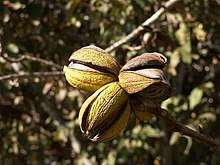 Ripe pecan nuts on tree
Ripe pecan nuts on tree Carya illinoinensis, MHNT
Carya illinoinensis, MHNT- Pecan halves
References
- "Carya illinoinensis". Germplasm Resources Information Network (GRIN). Agricultural Research Service (ARS), United States Department of Agriculture (USDA). Retrieved 2009-10-15.
- Conner, Patrick J (2018). "Pecan breeding". College of Agricultural and Environmental Sciences, University of Georgia. Retrieved 5 December 2018.
- "USDA Pecan Breeding Program, National Clonal Germplasm Repository for Pecans and Hickories". Horticulture Dept. Retrieved 6 Dec 2017.
- "Pecan, n." OED Online. Oxford University Press. March 2016.
French (Mississippi Valley) pacane (1712; 1721 in the source translated in quot. 1761 at sense 1); Illinois pakani (= /pakaːni/); cognates in other Algonquian languages are applied to hickory nuts and walnuts. Compare Spanish pacano (1772; 1779 in a Louisiana context).
- See "Pecan" at Wiktionary.
- Harvard Dialect Survey, Bert Vaux and Scott Golder, 2003.
- Flora of North America: Carya illinoinensis
- Oklahoma Biological Survey: Carya illinoinensis
- Bioimages: Carya fruits
- Collingwood, G. H., Brush, W. D., & Butches, D., eds. (1964). Knowing your trees. 2nd ed. American Forestry Association, Washington, DC.
- "Pecan kernel". Texas A&M University. 2006-08-18. Retrieved 22 September 2017.
- "Pecans". Agricultural Marketing Resource Center. August 2015. Retrieved 22 September 2017.
- "2017 World Pecan Production". Pecan Report. 2017. Retrieved 22 September 2017.
- "Pecan Breeding". University of Georgia College of Agricultural and Environmental Sciences. 2017. Retrieved 22 September 2017.
- Grauke, L. J. "Pecan flowering".
- Pecan Breeding. "Cultivars - Recommended Cultivar List". pecanbreeding.uga.edu.
- Stein & Kamas. "Improved Pecans" (PDF). aggie-horticulture.tamu.edu.
- carya species. "gov/carya species/illinoinensis ilnatdis". cgru.usda.gov.
- HORTSCIENCE. "'Norten˜a' Pecan" (PDF). hortsci.ashspublications.org.
- Infap. "Tecnología de Producción en Nogal Pecanero" (PDF). biblioteca.inifap.gob.mx (in Spanish).
- Smith, Michael W.; Carroll, Becky L.; Cheary, Becky S. (1 September 1992). "Chilling Requirement of Pecan". Journal of the American Society for Horticultural Science. pp. 745–748.
- Grauke. "Pecan Cultivars-Western". cgru.usda.gov.
- "USDA Pecan Breeding Program, National Clonal Germplasm Repository for Pecans and Hickories". Horticulture Dept. Retrieved 6 Dec 2017.
- Conner, Patrick; Sparks, Darrell. "'Elliott' Pecan" (PDF). Department of Horticulture, University of Georgia. Retrieved Dec 6, 2017. Cite journal requires
|journal=(help) - "Kanza, Cultivars". College of Agricultural and Environmental Sciences, University of Georgia. 2018. Retrieved 5 December 2018.
- Allen V. Barker; D. J. Pilbeam (2007). Handbook of plant nutrition. CRC Press. pp. 399–. ISBN 978-0-8247-5904-9. Retrieved 15 December 2017.
- Greg Morago (18 December 2017). "Pecan pralines a sweet tradition (no matter how you say it)". Houston Chronicle. Retrieved 5 December 2018.
- "Pecan". The Wood Database. 2018. Retrieved 5 December 2018.
- Noma Nazish (17 April 2018). "Grill Gourmet: The Best Wood And Food Pairings To Try This Season". Forbes. Retrieved 5 December 2018.
- "Nuts, raw pecans per 100 g". Nutrition Facts. Conde Nast, USDA National Nutrient Database, version SR 21. 2014. Retrieved 2009-10-09.
- Donald E. Stone; et al. "New World Juglandaceae. II. Hickory Nut Oils, Phenetic Similarities, and Evolutionary Implications in the Genus Carya". American Journal of Botany. Botanical Society of America. 56: 928–935. doi:10.2307/2440634. JSTOR 2440634.
- Manos, Paul; Stone, Donald E. (2001). "Evolution, Phylogeny, and Systematics of Juglandaceae" (PDF). Annals of the Missouri Botanical Garden. Missouri Botanical Garden Press. 88 (2): 231–269. doi:10.2307/2666226. JSTOR 2666226.
- Grauke, L J. "Pecan cultivars: Centennial". Pecan cultivars. USDA-ARS Pecan Genetics. Retrieved 6 July 2020.
- Grauke, L. J. "Pecan, C. illinoenensis".
- Texas State Symbols, Texas State Library and Archives Commission, August 30, 2017, retrieved 2019-05-15
- "Town website for San Saba, Texas". Town of San Saba Texas.
- Glentzer, Molly (July 12, 2001), "Pecan territory", Saveur, retrieved 2019-05-15
- "Official Alabama Nut". Official Symbols and Emblems of Alabama. Alabama Department of Archives and History. February 6, 2014. Retrieved 2019-05-07.
- Ware, David (March 8, 2018). "Official State Nut". The Encyclopedia of Arkansas History & Culture. The Central Arkansas Library System. Retrieved 2019-05-15.
- "State Symbols". State History. California Stale Library. Retrieved 2019-05-15.
- Everett, Dianna, State Meal, Oklahoma Historical Society, retrieved 2019-05-15
External links
| Wikimedia Commons has media related to Carya illinoinensis. |
| Look up pecan in Wiktionary, the free dictionary. |
- Carya illinoinensis images at the Arnold Arboretum of Harvard University Plant Image Database
- Carya illinoinensis images at bioimages.vanderbilt.edu
- National Center for Home Food Preservation—Home Preservation of pecans
- USDA Forest Service: Carya illinoensis
- Interactive Distribution Map of Carya illinoensis
- The Pecan and its Culture at Project Gutenberg (Text from 1906)
- First Pecan Trees Grown Here About 1840 historical marker at St. Marys, Georgia